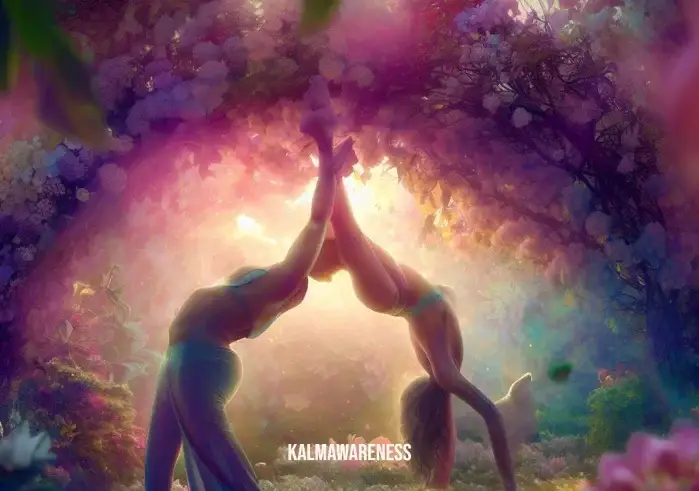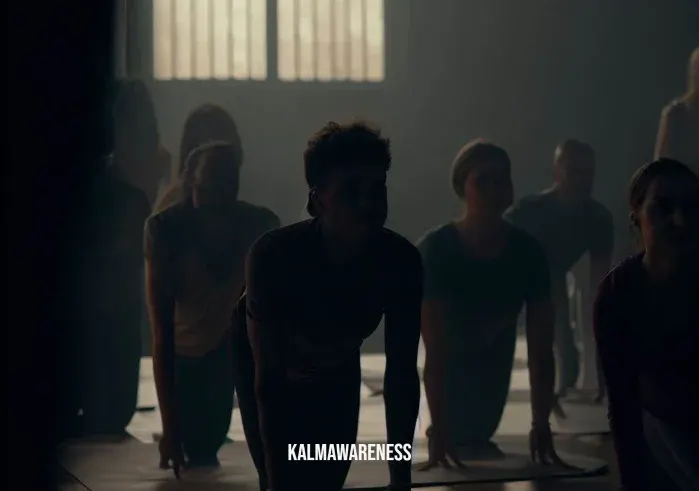Yoga Pose: Stretching into the Wheel Pose
In the world of yoga, there are numerous poses that offer a range of physical and mental benefits. Among them, the “Wheel Pose,” also known as “Stretch Pose,” stands out as a powerful and invigorating posture that challenges the body and opens the heart. In this article, we’ll explore the ins and outs of the Wheel Pose, its original name, difficulty level, category, recommended exercise duration, and step-by-step guide to achieve it.
Yoga Pose Details
| Description | Explanation |
|---|---|
| Pose Name | Wheel Pose (Stretch Pose) |
| Original Name | Chakrasana |
| Difficulty Level | Intermediate to Advanced |
| Pose Category | Backbend |
| Exercise Duration | For beginners: Hold for 15-30 seconds |
| For advanced practitioners: Hold for 1 minute |
Introduction to the Wheel Pose
The Wheel Pose, or Chakrasana, is a backbend that resembles the shape of a wheel when fully expressed. This dynamic posture is not only visually striking but also offers numerous benefits for the body, mind, and spirit. As you stretch into the Wheel Pose, you will experience a sense of expansion and release, opening up your heart and freeing your energy centers.
The Connection to Yoga Clusters
The Wheel Pose is an integral part of the Yoga cluster focused on backbends and heart-opening postures. In this cluster, practitioners explore poses that strengthen the spine, increase flexibility, and cultivate feelings of joy and compassion. As we delve deeper into the Yoga Pose, you will discover how it complements and contributes to this cluster’s overall practice.
The Benefits of the Wheel Pose
Embracing the Wheel Pose as a regular part of your yoga practice can yield a multitude of advantages for your physical and mental well-being. Some of the key benefits include:
- Spinal Flexibility: The Wheel Pose is an excellent pose to promote spinal flexibility, as it stretches and opens the entire length of the spine, from the cervical to the lumbar region.
- Strengthened Muscles: This pose engages a wide range of muscles, including the legs, arms, shoulders, and back muscles, leading to increased strength and stability.
- Heart Opening: As you lift your chest and arch your back, the Wheel Pose facilitates an expansive heart opening, which can evoke feelings of vulnerability, self-compassion, and connection.
- Energy Flow: By opening the front side of your body, the Wheel Pose encourages the smooth flow of energy (Prana) through the various energy channels (Nadis) in the body.
- Improved Posture: Regular practice of this backbend can help correct rounded shoulders and improve overall posture.
How to Practice the Wheel Pose
Before attempting the Wheel Pose, it’s crucial to warm up properly and ensure that your body is adequately prepared for this intermediate to advanced posture.
Step-by-Step Guide:
- Preparation: Lie flat on your back with your knees bent and feet firmly placed on the mat, hip-width apart. Bend your elbows and place your hands beside your shoulders, fingers pointing toward your shoulders.
- Lift Into Bridge Pose: Press into your palms and feet as you lift your hips and shoulders off the mat, coming into Bridge Pose. Take a few breaths here to ground yourself and establish stability.
- Entering the Wheel: As you exhale, push through your palms and feet, lifting your torso off the mat. Straighten your arms and legs as much as possible, creating a deep backbend. Allow your head to hang naturally or gently tuck your chin, depending on your comfort.
- Find Your Alignment: Ensure that your wrists are directly under your shoulders and your feet are parallel, knees hip-width apart. Engage your core and thighs to maintain stability.
- Hold and Breathe: Breathe deeply and evenly as you hold the pose. For beginners, start with holding the pose for 15-30 seconds. As you progress, you can extend the duration to 1 minute for advanced practice.
- Exiting the Pose: To release, tuck your chin and bend your elbows, slowly lowering yourself back to Bridge Pose. Gently roll your spine back down onto the mat and take a moment to rest in Corpse Pose (Shavasana).

Stretching into the Wheel Pose
Embracing the Wheel Pose – Benefits, Variations, and Safety Precautions
In Part 1, we explored the fundamentals of the Wheel Pose, also known as the Stretch Pose in yoga, and learned how to practice it step by step. Now, in Part 2, we will delve deeper into the world of this powerful backbend and discover its various benefits, variations for different experience levels, and safety precautions to ensure a safe and fulfilling practice.
The Many Benefits of the Wheel Pose
The Wheel Pose offers a wide array of benefits that extend beyond physical flexibility and strength. As we hold this heart-opening posture, we tap into a wellspring of advantages that nurture our body, mind, and spirit:
- Energizing and Invigorating: The Wheel Pose is known for its ability to awaken and energize the body, making it an excellent addition to morning or midday yoga routines.
- Stimulates the Nervous System: As a backbend, the Wheel Pose stimulates the central nervous system, leaving us feeling rejuvenated and focused.
- Boosts Confidence and Emotional Release: Practicing this empowering pose can help release pent-up emotions and foster a sense of confidence and fearlessness.
- Therapeutic for Asthma and Allergies: The expansive nature of the Wheel Pose can aid in opening the chest and increasing lung capacity, potentially benefitting those with asthma and allergies.
- Thyroid and Hormonal Regulation: The Wheel Pose stimulates the thyroid gland, which plays a crucial role in hormonal regulation.
- Strengthens the Arms, Shoulders, and Back: Holding the Wheel Pose requires significant upper body strength, making it an excellent pose for building muscular endurance.
- Improves Digestion: The gentle compression of the abdominal organs in this backbend can aid in digestion and alleviate digestive issues.
Who Should Avoid the Wheel Pose?
While the Wheel Pose offers numerous benefits, it is essential to acknowledge that this pose may not be suitable for everyone. Individuals with the following conditions or limitations are advised to avoid attempting the Wheel Pose:
- Back Injuries: Those with chronic or acute back injuries should steer clear of this intense backbend, as it could exacerbate existing issues.
- Wrist or Shoulder Problems: The Wheel Pose places significant pressure on the wrists and shoulders, so individuals with injuries or discomfort in these areas should refrain from attempting it.
- Neck Issues: As the Wheel Pose involves dropping the head back, it’s not recommended for individuals with neck injuries or issues.
- High Blood Pressure: This posture can cause a significant surge in blood pressure, so individuals with uncontrolled high blood pressure should avoid it.
- Carpal Tunnel Syndrome: The pressure on the wrists in the Wheel Pose may worsen symptoms for those with Carpal Tunnel Syndrome.
Variations for Different Levels of Experience
The beauty of yoga lies in its adaptability to meet practitioners where they are in their journey. The Wheel Pose offers various modifications and variations to cater to different levels of experience:
- Half Wheel Pose (Ardha Chakrasana): For beginners or those still building strength and flexibility, Half Wheel Pose is an excellent alternative. Instead of fully lifting into the pose, the practitioner lifts the chest and head while keeping the palms and feet on the mat.
- Wall-Assisted Wheel Pose: Practicing against a wall provides support and helps beginners work on alignment and strength. The wall allows for a gentler backbend while still reaping some of the pose’s benefits.
- One-Legged Wheel Pose (Eka Pada Chakrasana): Intermediate practitioners can explore the challenge of lifting one leg off the mat while in the Wheel Pose, engaging the core and deepening the backbend.
- Full Expression with Advanced Variations: Advanced practitioners can experiment with deeper backbends, such as walking the hands closer to the feet or attempting the pose with straight legs.

Stretching into the Wheel Pose
Unveiling the Heart of the Wheel Pose – History, Spiritual Significance, and More
In the first two parts of this article, we dived into the physical aspects of the Wheel Pose, its benefits, who should avoid it, and variations to suit different levels of experience. Now, in Part 3, we embark on a journey into the heart of this transformative backbend, exploring its rich history, spiritual significance, tips for an enriched practice, common mistakes to avoid, modifications for specific needs, and poses that complement the Wheel Pose.
The Ancient Roots of the Wheel Pose
As with many yoga asanas, the Wheel Pose boasts a rich historical background that dates back thousands of years. Its original name, “Chakrasana,” is derived from the Sanskrit words “chakra” (wheel) and “asana” (pose), which translates to “Wheel Pose.” The name refers to the shape the body takes, resembling a wheel when fully expressed in the posture.
Ancient yogis viewed the Wheel Pose as a symbolic representation of the opening of the heart chakra (Anahata), which is associated with love, compassion, and self-acceptance. This deep heart-opening gesture served as a pathway to connect with one’s inner self and cultivate a profound sense of love and connection to others and the universe.
The Spiritual Significance of the Wheel Pose
Beyond its physical benefits, the Wheel Pose holds immense spiritual significance. It serves as a gateway to self-discovery and inner growth, encouraging practitioners to release emotional blockages and fears, and embrace vulnerability and authenticity.
When we arch back into the Wheel Pose, we expose our heart center, making ourselves vulnerable in body and spirit. This symbolic gesture teaches us to let go of emotional armor and embrace our true selves, imperfections and all. By doing so, we learn to love ourselves unconditionally and, in turn, extend that love and compassion to others.
Tips for a Deeper Wheel Pose Practice
To make the most of your Wheel Pose experience, consider the following tips:
- Warm-Up Mindfully: Before attempting the Wheel Pose, ensure your body is adequately warmed up. Gradually work through preparatory poses, such as Bridge Pose and Camel Pose, to prepare your back and shoulders.
- Engage Core and Legs: As you lift into the pose, engage your core and leg muscles to support your backbend and maintain stability.
- Breathe Steadily: Focus on deep and controlled breathing throughout the pose. Allow the breath to guide you and create space within your body.
- Soft Gaze: Soften your gaze and release any tension in your face and jaw as you hold the Wheel Pose.
- Release Gradually: When coming out of the pose, lower down with control and mindfulness. Avoid abrupt movements that may strain your back or wrists.
Common Mistakes to Avoid
To avoid unnecessary strain and ensure a safe practice, watch out for these common mistakes in the Wheel Pose:
- Overarching the Neck: Avoid dropping the head too far back, as this can lead to strain in the neck and cervical spine.
- Collapsing the Shoulders: Keep your shoulders drawn away from the ears to prevent unnecessary tension.
- Splaying the Elbows: Ensure your elbows are parallel and not splayed out to the sides, which can strain the shoulders.
- Gripping the Glutes: Avoid excessive squeezing of the glutes, as it can lead to tension in the lower back.
Modifications for Specific Needs
For individuals with injuries or limited flexibility, there are modifications to make the Wheel Pose more accessible:
- Block Support: Place yoga blocks under your hands for added support and to decrease the depth of the backbend.
- Wall Assistance: Practice the Wheel Pose against a wall to help guide your alignment and offer support.
- Bridge Pose Variation: For those working on strength and flexibility, begin with Bridge Pose and gradually work toward the full Wheel Pose.
Complementary Poses to the Wheel Pose
Pairing the Wheel Pose with other asanas can enhance its benefits and deepen your practice. Consider incorporating the following poses into your yoga routine:
- Child’s Pose (Balasana): Counterbalance the backbend with a gentle forward bend to stretch and release the back.
- Camel Pose (Ustrasana): Prepare for the Wheel Pose by practicing Camel Pose to warm up the spine and open the heart.
- Fish Pose (Matsyasana): Follow up the Wheel Pose with Fish Pose to further expand the chest and throat region.
Embrace the Wheel Pose Journey
The Wheel Pose, or Chakrasana, is a profound journey of self-discovery, love, and acceptance. As you embrace this transformative backbend, remember to approach it with patience, reverence, and self-compassion. Allow the Wheel Pose to awaken the energy of your heart and connect you to your true essence.
In the final part of this article, we’ll delve into the ways the Wheel Pose can complement and elevate your overall yoga practice, tying together the physical, emotional, and spiritual aspects of this extraordinary pose.




